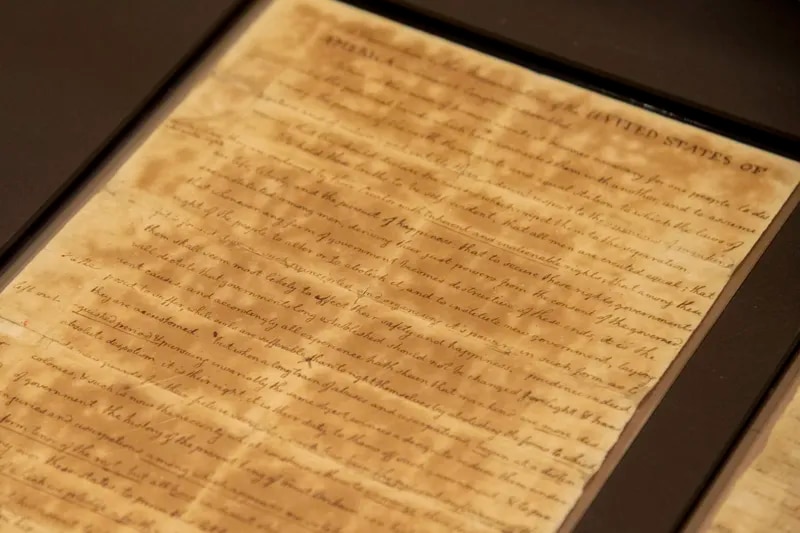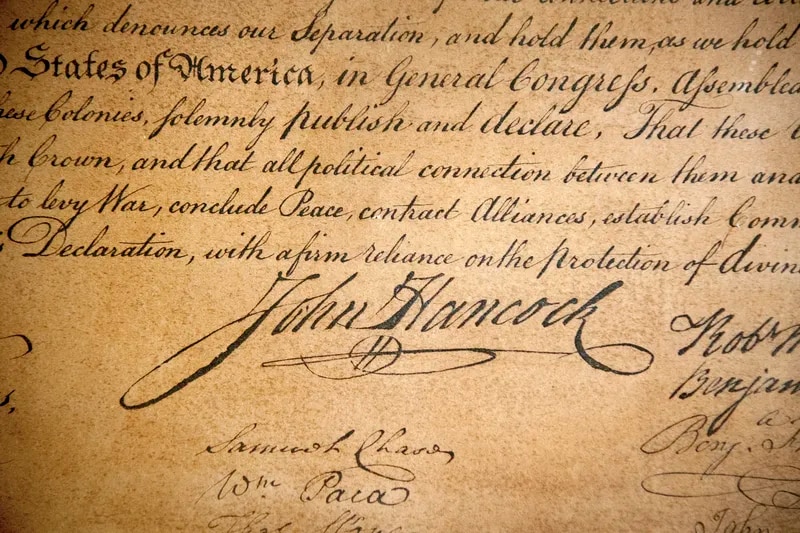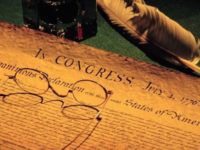Turns out it’s even more special!
Archivists at the American Philosophical Society suspected the rare engraving may have been more than a “cheap Victorian facsimile,” but it took quite a while to make sure.

American Philosophical Society’s head of conservation Anne Downey (left) and Patrick Spero, director of the library, open their copy of the original Declaration of Independence ordered up by President John Quincy Adams in 1820, but not completed until 1823. ~ TOM GRALISH / Staff Photographer
The archive of the American Philosophical Society, consisting of an ever-expanding universe of 13 million manuscripts and 350,000 bound volumes and periodicals, with images and audiotapes proliferating on a daily basis, has reached the point where it is its own universe.
So it should be no surprise that APS, founded in 1743, has discovered that it possesses an exceedingly rare engraved copy of the Declaration of Independence ordered up by John Quincy Adams two centuries ago, and given to the society in 1842 by Daniel Webster. The society has just announced the discovery.
The unearthed document now ascends to APS’s pantheon of Declarations consisting of rare drafts and early printed copies from newspapers, broadsides, and pamphlets held.
There are no immediate plans to exhibit this unusual Declaration, engraved by William J. Stone, but it would be instantly recognizable to anyone who has ventured into a gift shop in the vicinity of Independence Mall. The original Declaration of Independence, held in the National Archives, is quite stressed and faded, almost retiring in its aspect. The Stone engraving, bold and clear, is the source for the countless copies exhibited and sold across the country.
They are copies of Stone’s copy.
“This find adds yet another piece to what may be one of the best collection of Declarations in the world,” society librarian Patrick Spero said in a statement. “The APS holds Thomas Jefferson’s handwritten draft of the Declaration, two Dunlap copies, one of which is the only known oversized copy, the first printing in the Pennsylvania Evening Post, and the first printing in Europe. We also have the chair that Thomas Jefferson is believed to have sat in to write the Declaration. Discovering that we have a Stone copy completes this story.”
But what exactly is a Stone copy?
Anne Downey, APS head of conservation, has spent more than a fair amount of time untangling that question and what it has come to mean.

A copy of the Declaration of Independence in Thomas Jefferson’s hand, sent to Richard Henry Lee by Jefferson, and viewed in the library of the American Philosophical Society a week ago. ~ TOM GRALISH / Staff Photographer
At the request of Adams, then secretary of state, Stone labored for three years to make an exact copper-plated rendering of the original Declaration, completing it in 1823. He pulled 201 copies on parchment to be given to the living signers of the document and to political heavyweights, a few institutions, and himself.
Adams had become alarmed at the deterioration of the original Declaration and sought to relieve it from daily workaday use with a copy, Downey said.
The APS copy is now holder of the eighth known paper printing of the Declaration made by Stone from his original copper plate. Stone printed 201 on parchment, which is made from animal skin and is distinct from paper; and quite a few of those survive, although precisely how many has not been determined. It is unknown how many he printed on paper.
Actually, it was not known that Stone printed any copies on paper — like the APS copy — until one was discovered elsewhere in 2002.
Around that same time, Valerie-Ann Lutz, now APS’s head of manuscripts processing, came upon a heavily varnished and browned copy of the Declaration in the APS archive. Looking at the brittle document, she had a strong hunch that it might be one of the original 201 that Stone printed on parchment.
“She got very excited,” Downey said. And for a while, it was generally believed that this Declaration was indeed a parchment Stone Declaration. A number of experts examined the oversize sheet. It even appeared in a documentary film on the Stone engravings.
Then in 2013, Seth Kaller, an expert on early American documents and Stone printings, was called in to examine the facsimile.
“He took a look at it, and he said, ‘Well, no, it’s not,’ and he just sort of brushed it off, and, I guess, assumed it was just some sort of cheap Victorian facsimile,” Downey said.
In the midst of this divided scholarly opinion, a researcher needed to use the APS Declaration in 2015.
“It was noticed at that point that it really needed conservation treatment. It was very, very brittle, very difficult to handle, etc., etc.,” Downey said. She puzzled over the document for quite some time.
“It had a very heavy coating of varnish, and when I got it, it was a piece of flat paper, very thick and very confusing looking,” she said. “I thought it was a lamination of thin paper onto a thicker paper because the top surface was very, very dark. And if you observe where the tears are, the interior of the tear is very white, and so I thought that was a secondary backing for this thin brown thing. It was just mind-boggling. I couldn’t figure it out. And the surface coating made it very yellow, dark, shiny.”
“Eventually,” she added, “we just decided to call it a lithograph” — not a copy from the original copper plate.
But that nagged, and eventually Downey and David Gary, associate director of collections, decided the document should be conserved.
“He said: ‘Well, you know, it’s dang brittle. We need to be able to access it once in a while, for researchers, so we can go ahead and treat it. We don’t know what it is — it’s probably a piece of Victorian junk,’” Downey recalled.

John Hanccck’s signature on the the engraved Declaration of Independence copy ordered up by President John Quincy Adams in 1820, in the library of the American Philosophical Society June 16, 2021. The APS discovered the very rare copy in its own archives. ~ TOM GRALISH / Staff Photographer
She went to work, painstakingly removing glue and varnish, and after every careful wash, the aspect of the document changed, becoming less like a lithograph and more like “I don’t know what,” she said.
But when Downey put the document under raking light, she could instantly tell that this was no lithograph but an engraving — letters cast shadows, clear indication of the printing process. And she could see the hatching marks from etching on the big “C” at the beginning of the Declaration, “In Congress, July 4, 1776.”
She was now in frequent consultation with Kaller, the expert, who made numerous suggestions and observations about Stone and his technique. Downey tested the paper, which proved to be thick and of very fine quality, not parchment at all — and not made from wood pulp like a “cheap Victorian” copy.
How many paper printings did Stone make? Why did he make them? At this point, there are no answers. But the research continues.
“We’ve mined in our own archives,” said Downey. “You know when you’re an old institution, there’s bound to be a few things that pop up now and then.”
Spero said: “The research library is the laboratory for the humanities, and people come into our reading room and it’ll be quiet and people will be sitting at these desks and it’ll look like they’re just reading. But what they’re actually doing is having a conversation that transcends time and place, and learning something new about the past. Even if you’ve held on to it for 200 years, they’re making a discovery right there and they’re gonna share it with the rest of the world.
“That is absolutely what we do. Libraries are really dynamic places.”
Written by Stephan Salisbury for The Philadelphia Inquirer – July 23, 2021

 FAIR USE NOTICE:
FAIR USE NOTICE: